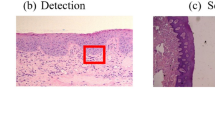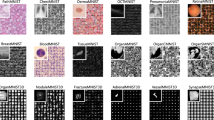Abstract
The development of mobile and on the edge applications that embed deep convolutional neural models has the potential to revolutionise healthcare. However, most deep learning models require computational resources that are not available in smartphones or edge devices; an issue that can be faced by means of compact models that require less resources than standard deep learning models. The problem with such models is that they are, at least usually, less accurate than bigger models. We propose to address the accuracy limitation of compact networks with the application of semi-supervised learning techniques. In particular, we perform a thorough comparison of self-training methods, consistency regularisation techniques, and quantization techniques. We present a thorough analysis for the results obtained by combining 11 compact networks and 6 semi-supervised processes when applied to 10 biomedical datasets. Namely, combining semi-supervised methods and compact networks, we can create compact models that are not only as accurate as standard size models, but also faster and lighter. In addition, we have developed a Python library to facilitate the combination of compact networks and semi-supervised learning methods to tackle image classification tasks.


Similar content being viewed by others
Explore related subjects
Discover the latest articles, news and stories from top researchers in related subjects.Data Availability
Enquiries about data availability should be directed to the authors.
References
Arredondo-Santoyo M, Domínguez C, Heras J et al (2019) Automatic characterisation of dye decolourisation in fungal strains using expert, traditional, and deep features. Soft Comput 23:12799–12812. https://doi.org/10.1007/s00500-019-03832-8
Azizi S, Mustafa B, Ryan F, Beaver Z, Freyberg J, Deaton J, Loh A, Karthikesalingam A, Kornblith S, Chen T et al (2021) Big self-supervised models advance medical image classification. In: Proceedings of the IEEE/CVF international conference on computer vision, pp 3478–3488
Berthelot D et al (2019) Mixmatch: a holistic approach to semi-supervised learning. In: 33rd international conference on neural information processing systems (NEURIPS’19). Curran Associates Inc, pp 5050–5060
Bucila C, Caruana R, Niculescu-Mizil A (2006) Model compression: making big, slow models practical. In: 12th international conference on knowledge discovery and data mining, KDD’06, pp. 535–541
Cai H, Gan C, Wang T, Zhang Z, Han S (2020) Once for all: train one network and specialize it for efficient deployment. In: International conference on learning representations. https://openreview.net/forum?id=HylxE1HKwS
Chaturvedi SS, Gupta K, Prasad PS (2020) Skin lesion analyser: an efficient seven-way multi-class skin cancer classification using mobilenet. In: AMLTA 2020: advanced machine learning technologies and applications. Advances in intelligent systems and computing, vol 1141. Springer, pp 165–176. https://doi.org/10.1007/978-981-15-3383-9_15
Chen S, Xiao N, Shi X, Yang Y, Tan H, Tian J, Quan Y (2023) Colormedgan: a semantic colorization framework for medical images. Appl Sci 13(5):3168
Chen T, Kornblith S, Swersky K, Norouzi M, Hinton GE (2020) Big self-supervised models are strong semi-supervised learners. Adv Neural Inf Process Syst 33:22243–22255
Codella NCF, Gutman D, Celebi ME et al (2017) Skin lesion analysis toward melanoma detection: a challenge at the international symposium on biomedical imaging (ISBI) 2016. In: Conference on computer vision and pattern recognition, CVPR’17
Cohen J (1969) Statistical power analysis for the behavioral sciences. Academic Press, Cambridge
Cubuk ED, et al (2020) Randaugment: Practical automated data augmentation with a reduced search space. In: 2020 IEEE/CVF Conference on Computer Vision and Pattern Recognition Workshops (CVPRW). pp. 3008–3017. IEEE . https://doi.org/10.1109/CVPRW50498.2020.00359
Deng J et al (2009) ImageNet: a large-scale hierarchical image database. In: IEEE computer society conference on computer vision and pattern recognition (CVPR09)
Garcia S et al (2010) Advanced nonparametric tests for multiple comparisons in the design of experiments in computational intelligence and data mining: Experimental analysis of power. Inf Sci 180:2044–2064
Giselsson TM, Jorgensen RN, Jensen PK et al (2017) A public image database for benchmark of plant seedling classification algorithms. arXiv:1711.05458
He K, Zhang X, Ren S, Sun J (2016) Deep residual learning for image recognition. In: 2016 IEEE conference on computer vision and pattern recognition (CVPR). IEEE, pp 770–778. https://doi.org/10.1109/CVPR.2016.90
Hinton G (2018) Deep learning—a technology with the potential to transform health care. JAMA 320(11):1101–1102. https://doi.org/10.1001/jama.2018.11100
Hinton G et al (2015) Distilling the knowledge in a neural network
Ho TKK, Gwak J (2020) Utilizing knowledge distillation in deep learning for classification of chest x-ray abnormalities. IEEE Access 8:160749–160761. https://doi.org/10.1109/ACCESS.2020.3020802
Howard J, Gugger S (2020) Fastai: a layered api for deep learning. Information 11:108. https://doi.org/10.3390/info11020108
Huang R, Noble JA, Namburete AIL (2018) Omni-supervised learning: Scaling up to large unlabelled medical datasets. In: medical image computing and computer assisted intervention, MICCAI’18. Springer, pp 572–580
Iandola FN et al (2016) Squeezenet: alexnet-level accuracy with 50x fewer parameters and \(<\)0.5mb model size
Inés A, Domínguez C, Heras J, Mata E, Pascual V (2021) Biomedical image classification made easier thanks to transfer and semi-supervised learning. Comput Methods Programs Biomed 198:105782
Irvin J, Rajpurkar P, Ko M et al (2019) Chexpert: a large chest radiograph dataset with uncertainty labels and expert comparison. In: Thirty-third AAAI conference on artificial intelligence, AAAI’19, vol 33, pp 590–597
Jiang H, Diao Z, Shi T, Zhou Y, Wang F, Hu W, Zhu X, Luo S, Tong G, Yao YD (2023) A review of deep learning-based multiple-lesion recognition from medical images: classification, detection and segmentation. Comput Biol Med 106726
Jiang N, Luo J, Lin J, Chen W, Zhao T (2023) Lightweight semi-supervised network for single image rain removal. Pattern Recogn 137:109277
Kaggle (2019a) Aptos 2019 blindness detection. https://www.kaggle.com/c/aptos2019-blindness-detection
Kaggle (2019b) Open sprayer images. https://www.kaggle.com/gavinarmstrong/open-sprayer-images
Kermany DS, Goldbaum M, Cai W et al (2018) Identifying medical diagnoses and treatable diseases by image-based deep learning. Cell 172(5):1122-1131.e9. https://doi.org/10.1016/j.cell.2018.02.010
Krishnamoorthi R (2018) Quantizing deep convolutional networks for efficient inference: a whitepaper. arXiv:1806.08342
Kumar J, Ye P, Doermann D (2014) Structural similarity for document image classification and retrieval. Pattern Recogn Lett 43:119–126. https://doi.org/10.1016/j.patrec.2013.10.030
Li F, Song D, Chen H et al (2020) Development and clinical deployment of a smartphone-based visual field deep learning system for glaucoma detection. npj Digit Med 3:120. https://doi.org/10.1038/s41746-020-00329-9
Li G et al (2020) Soft-label anonymous gastric x-ray image distillation. In: 2020 IEEE international conference on image processing (ICIP). IEEE, pp 305–309. https://doi.org/10.1109/ICIP40778.2020.9191357
Liu Z, Mao H, Wu CY, Feichtenhofer C, Darrell T, Xie S (2022) A convnet for the 2020s. In: Proceedings of the IEEE/CVF conference on computer vision and pattern recognition (CVPR)
Luo L, Xue D, Feng X (2020) Automatic diabetic retinopathy grading via self-knowledge distillation. Electronics 9(9):1337. https://doi.org/10.3390/electronics9091337
Marcolino MS, Oliveira JAQ, D’Agostino M et al (2018) The impact of mhealth interventions: systematic review of systematic reviews. JMIR Mhealth Uhealth 6(1):e23. https://doi.org/10.2196/mhealth.8873
Mehta S, Rastegari M (2022) Mobilevit: light-weight, general-purpose, and mobile-friendly vision transformer. In: International conference on learning representations. https://openreview.net/forum?id=vh-0sUt8HlG
Meijering E (2020) A bird’s-eye view of deep learning in bioimage analysis. Comput Struct Biotechnol J 18(1):2312–2325. https://doi.org/10.1016/j.csbj.2020.08.003
Paszke A et al (2022) Pytorch: an imperative style, high-performance deep learning library. In: Wallach H, Larochelle H, Beygelzimer A, d’ Alché-Buc F, Fox E, Garnett R (eds) Advances in neural information processing systems, vol 32. Curran Associates, Inc., pp 8024–8035
Pogorelov K, Randel KR, Griwodz C et al (2017) Kvasir: A multi-class image dataset for computer aided gastrointestinal disease detection. In: 8th ACM on multimedia systems conference, MMSys’17. ACM, pp 164–169. https://doi.org/10.1145/3083187.3083212
Qayyum A, Tahir A, Butt MA, Luke A, Abbas HT, Qadir J, Arshad K, Assaleh K, Imran MA, Abbasi QH (2023) Dental caries detection using a semi-supervised learning approach. Sci Rep 13(1):749
Qin J, Wu J, Li M, Xiao X, Zheng M, Wang X (2022) Multi-granularity distillation scheme towards lightweight semi-supervised semantic segmentation. In: European conference on computer vision. Springer, pp 481–498
Razavian AS, Azizpour H, Sullivan J et al (2014) CNN features off-the-shelf: an astounding baseline for recognition. In: IEEE conference on computer vision and pattern recognition workshops, CVPRW’14. IEEE, pp 512–519
Sajjadi M et al (2016) Regularization with stochastic transformations and perturbations for deep semi-supervised learning. In: 30th International conference on neural information processing systems (NIPS’16). Curran Associates Inc, pp 1171–1179
Sandler M, Howard A, Zhu M et al (2018) Mobilenetv2: inverted residuals and linear bottlenecks. In: 2018 IEEE/CVF conference on computer vision and pattern recognition (CVPR). IEEE, pp 4510–4520. https://doi.org/10.1109/CVPR.2018.00474
Sheskin D (2011) Handbook of parametric and nonparametric statistical procedures. CRC Press, London
Shuvo MMH (2022) Edge ai: leveraging the full potential of deep learning. In: Recent innovations in artificial intelligence and smart applications, pp 27–46. Springer
Shuvo MMH, Islam SK, Cheng J, Morshed BI (2023) Efficient acceleration of deep learning inference on resource-constrained edge devices: a review. Proc IEEE 111(1):42–91. https://doi.org/10.1109/JPROC.2022.3226481
Simard P, Steinkraus D, Platt JC (2003) Best practices for convolutional neural networks applied to visual document analysis. In: Proceedings of the 12th international conference on document analysis and recognition (ICDAR’03), vol 2, pp 958–964
Smith L (2017) Cyclical learning rates for training neural networks. In: IEEE Winter conference on applications of computer vision. WACV’17, pp 464–472. https://doi.org/10.1109/WACV.2017.58
Sohn K et al (2020) Fixmatch: simplifying semi-supervised learning with consistency and confidence. In: 34th international conference on neural information processing systems (NEURIPS’20). Curran Associates Inc
Suriyal S, Druzgalski C, Gautam K (2018) Mobile assisted diabetic retinopathy detection using deep neural network. In: 2018 global medical engineering physics exchanges/pan American Health Care Exchanges (GMEPE/PAHCE). IEEE, pp 1–4. https://doi.org/10.1109/GMEPE-PAHCE.2018.8400760
Tan M, Le QV (2019) Efficientnet: rethinking model scaling for convolutional neural networks. In: International conference on machine learning, vol 97. ICML 2019, pp 6105–6114
Tan M, Le QV (2019) Mixconv: mixed depth wise convolutional kernels. In: 30th British machine vision conference 2019 (BMVC 2019), pp. 1–13
Tan M et al (2019) Mnasnet: platform-aware neural architecture search for mobile. In: 2019 IEEE/CVF conference on computer vision and pattern recognition (CVPR). IEEE, pp 2815–2823. https://doi.org/10.1109/CVPR.2019.00293
Triguero I et al (2015) Self-labeled techniques for semi-supervised learning: taxonomy, software and empirical study. Knowl Inf Syst 42:245–284. https://doi.org/10.1007/s10115-013-0706-y
Tschandl P, Rosendahl C, Kittler H (2018) The HAM10000 dataset: a large collection of multi-source dermatoscopic images of common pigmented skin lesions. Sci Data. https://doi.org/10.1038/sdata.2018.161
Upadhyay AK, Bhandari AK (2023) Semi-supervised modified-unet for lung infection image segmentation. IEEE Trans Radiat Plasma Med Sci. https://doi.org/10.1109/TRPMS.2023.3272209
Wiedemann S et al (2020) Deepcabac: a universal compression algorithm for deep neural networks. IEEE J Sel Top Signal Process 14(4):700–714. https://doi.org/10.1109/JSTSP.2020.2969554
Wu B, Dai X, Zhang P et al (2019) Fbnet: hardware-aware efficient convnet design via differentiable neural architecture search. In: 2019 IEEE/CVF conference on computer vision and pattern recognition (CVPR). IEEE, pp 10726–10734. https://doi.org/10.1109/CVPR.2019.01099
Zhang X et al (2018) Shufflenet: an extremely efficient convolutional neural network for mobile devices. In: 2018 IEEE/CVF conference on computer vision and pattern recognition (CVPR). IEEE, pp 6848–6856. https://doi.org/10.1109/CVPR.2018.00716
Zhu X, Goldberg AB (2009) Introduction to semi-supervised learning, synthesis lectures on artificial intelligence and machine learning. Morgan & Claypool Publishers, San Rafael
Funding
This work was partially supported by Ministerio de Ciencia e Innovación [PID2020-115225RB-I00 / AEI / 10.13039/501100011033], and FPU Grant 16/06903 of the Spanish MEC.
Author information
Authors and Affiliations
Contributions
AI: methodology, software, validation, investigation, and writing—original draft. AD-P: conceptualization, and writing—review and editing. CD: supervision, funding acquisition, validation, formal analysis, and writing—review and editing. JH: supervision, validation, formal analysis, and writing—review & editing. EM supervision and writing—review and editing. VP: supervision, funding acquisition, and writing—review and editing.
Corresponding author
Ethics declarations
Conflict of interest
None declared.
Ethical approval
Not applicable.
Informed consent
Not applicable.
Additional information
Publisher's Note
Springer Nature remains neutral with regard to jurisdictional claims in published maps and institutional affiliations.
Rights and permissions
Springer Nature or its licensor (e.g. a society or other partner) holds exclusive rights to this article under a publishing agreement with the author(s) or other rightsholder(s); author self-archiving of the accepted manuscript version of this article is solely governed by the terms of such publishing agreement and applicable law.
About this article
Cite this article
Inés, A., Díaz-Pinto, A., Domínguez, C. et al. Analysing semi-supervised learning for image classification using compact networks in the biomedical context. Soft Comput 28, 8931–8943 (2024). https://doi.org/10.1007/s00500-023-09109-5
Accepted:
Published:
Issue Date:
DOI: https://doi.org/10.1007/s00500-023-09109-5




